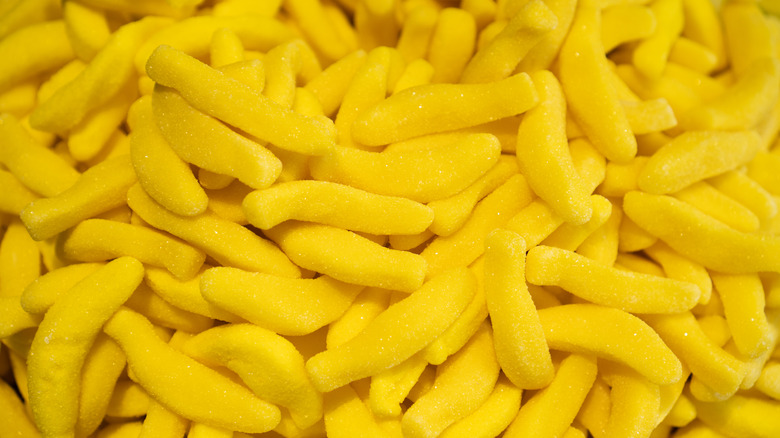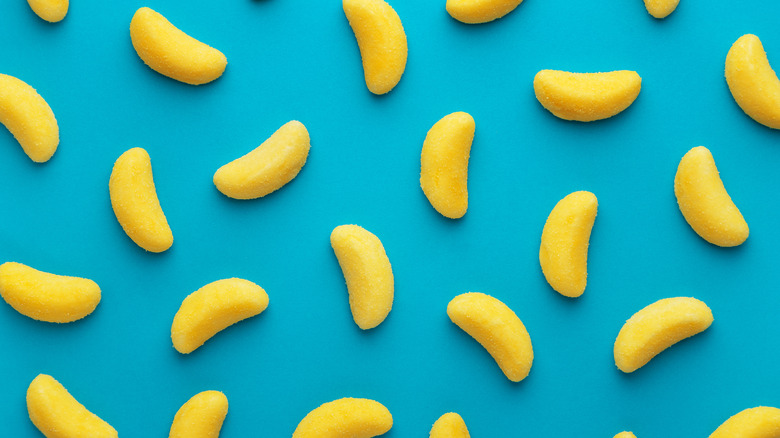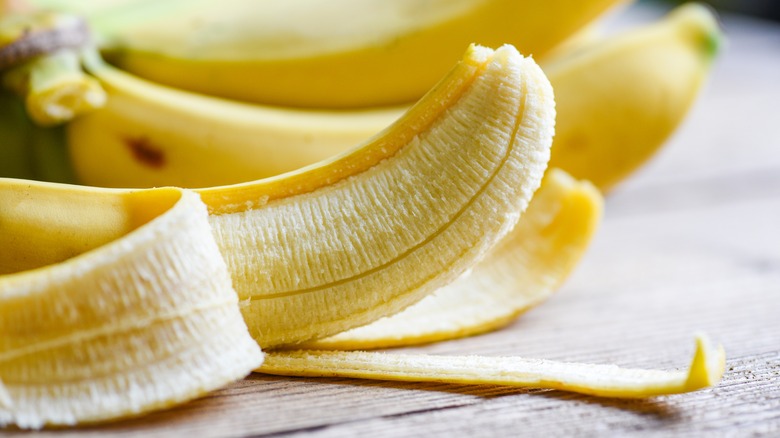Banana Candy Does Taste Like Bananas, Just Not The Kind You Know
When you were younger, did you have a favorite flavor of candy? Maybe you have a different one now. Some may say they like cherry-flavored candy because of how tart and sweet it is. Others may be drawn to strawberry candies, like the strawberry hard candies you can only seem to find at your grandmother's place. Some like blue raspberry, simply because it has the cool effect of turning tongues blue. But how many of you would say that banana-flavored candies are your favorite? In fact, if you think about it, don't those banana candies taste more like some vague notion of how a banana is supposed to taste instead of tasting like an actual honest-to-goodness banana?
Indeed, in the world of fruit-flavored candies, bananas seem to be the odd one out of the bunch. Fruit-flavored candies are typically based on certain types of fruit, which gives them their trademark flavor. For example, while table grapes may not taste like grape lollipops, grape-flavored candies are meant to approximate the Concord variety of grapes, those dark purple orbs with a deeply sweet flavor (via Specialty Produce). Cherry-flavored candies are, according to food historian Nadia Berenstein, aiming for wild cherries rather than the kind of maraschino cherries you get out of the jar (via Science Friday).
But if all fruit-flavored candies are based on a real type of fruit, how did candy makers get the flavor of banana so wrong?
Banana candies are based on an extinct banana
If you were to go up to someone selling apples and ask for an apple, you'd probably be offered many different varieties of apples. You may get a Red Delicious, a Pink Lady, a Granny Smith, or a Cosmic Crisp. Just as there are different types of apples, there are different types of bananas — and one such banana was the basis of banana-flavored candy.
According to Food & Wine, there existed a type of banana known as the "Gros Michel," a banana that was incredibly popular during the twentieth century. So popular was the Gros Michel banana that it made up an enormous percentage of banana exports to the United States in its day. The Gros Michel was described as being a fatter and sweeter version of the bananas we enjoy today — banana candies were supposedly based off the flavor of this wildly popular banana.
But what happened to the Gros Michel? America's Test Kitchen tells us that, sometime in the late 1950s and early 1960s, a plant-based fungus attacked the banana crops, eradicating most of the Gros Michel variety. The bananas that survived, the Cavendish bananas, quickly took over as the main banana export. Banana candies are strange tasting to us because the modern-day banana tastes nothing like the banana type they were based on.
Yet, is it true that the Gros Michel is the inspiration behind banana candy?
There may be some truth to that claim
It may sound a bit far-fetched to consider that one single type of banana was enough to influence how we eat banana candies in Runts and Laffy Taffy today. But to see if such a claim is true, someone has to get the flavor profile of a Gros Michel banana to see if it matches the flavor of banana candies.
That someone was Chris Baraniuk, a journalist for the BBC. In 2014, Baraniuk was able to talk to one Rob Guzman, a Hawaiian banana farmer, who described the flavor of a Gros Michel banana as being "sort of amplified, sweeter and, yeah, somehow artificial." Baraniuk also reports, however, that some such as synthetic organic chemist Derek Lowe believe that the Gros Michel itself isn't the sole inspiration for the taste of banana-flavored candies, but rather it's a compound known as "isoamyl acetate."
The American Chemical Society tells us that isoamyl acetate is naturally produced in fruit and has a strong "banana or pear" odor, perfect for flavoring foods such as candies and confections. This would mean that it's not Gros Michel bananas that aren't exactly the only flavor behind banana candies, but it's the chemical compound in them and other bananas that make banana-flavored candies taste the way they do.
Ain't that an a-peeling fact?


